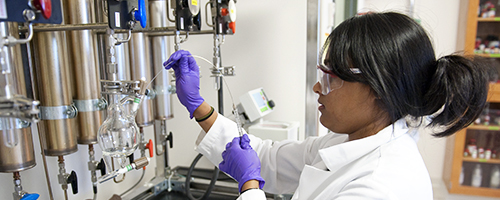Document Type
Article
Publication Date
10-15-2012
Publication Title
Journal of Chemical Educaton
Abstract
This three-week advanced-level organic experiment provides students with an inquiry-based approach focused on learning traditional skills such as primary literature interpretation, reaction design, flash column chromatography, and NMR analysis. Additionally, students address higher-order concepts such as the origin of azulene’s blue color, the mechanism of the Danheiser annulation (step 1), identification of an unknown reaction byproduct, and rationalization of a selective electrophilic aromatic substitution reaction (step 2). Students are initially drawn in by the fascinating color of azulene and remain engaged by the intriguing questions that naturally occur during this investigation.
Keywords
Carbocations, Chromatography, Electrophilic Substitution, Inquiry-Based/Discovery Learning, Laboratory Instruction, Mechanisms of Reactions, NMR Spectroscopy, Organic Chemistry, Synthesis, Upper-Division Undergraduate
Volume
90
Issue
1
First Page
110
Last Page
114
DOI
10.1021/ed300022a
Rights
“This document is the Accepted Manuscript version of a Published Work that appeared in final form in Journal of Chemical Education, copyright © American Chemical Society after peer review and technical editing by the publisher. To access the final edited and published work see [insert ACS Articles on Request author-directed link to Published Work, see http://pubs.acs.org/doi/abs/10.1021/ed300022a
Version
Author's Accepted Manuscript
Recommended Citation
Thomas, Rebecca M. and Shea, Kevin M., "Synthesis of Di- and Trisubstituted Azulenes Using a Danheiser Annulation as the Key Step: An Advanced Organic Laboratory Experiment" (2012). Chemistry: Faculty Publications, Smith College, Northampton, MA.
https://scholarworks.smith.edu/chm_facpubs/13


